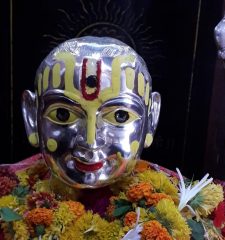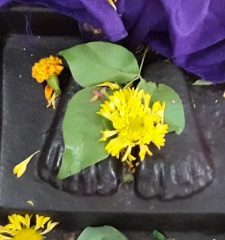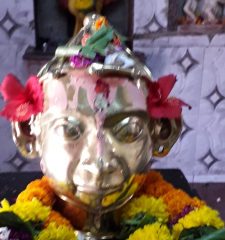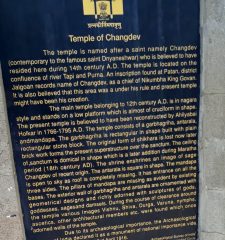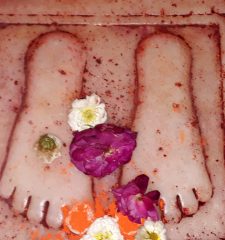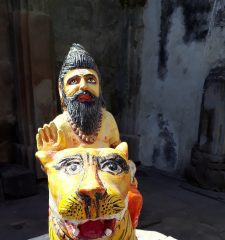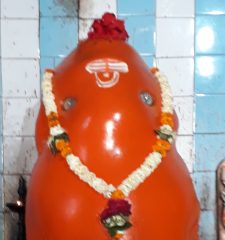Sant Dnyaneshwar
Dnyaneshwar (IAST: Jñāneśvar), also referred to as Jnaneshwar, Jnanadeva, Dnyandev or Mauli (1275–1296) was a 13th-century Marathi saint, poet, philosopher and yogi of the Nath Vaishnava tradition. In his short life of 21 years, he authored Dnyaneshwari (a commentary on the Bhagavad Gita) and Amrutanubhav. These are the oldest surviving literary works in the Marathi language, under the patronage of the Yadava dynasty of Devagiri, and these are considered to be milestones in Marathi literature. Dnyaneshwar’s ideas reflect the non-dualistic Advaita Vedanta philosophy and an emphasis on Yoga and oneness of Vishnu and Shiva.[6] His legacy inspired saint-poets such as Eknath and Tukaram, and he has been one of the foundations of the Varkari (Vithoba-Krishna) Bhakti movement tradition of Hinduism in Maharashtra.
He was born in 1275 (on the auspicious day of Krishna Janmashtami) in a Marathi-speaking Deshastha Brahmin family in Apegaon village on the bank of Godavari river near Paithan in Maharashtra during the reign of the Yadava king Ramadevarava. The kingdom with its capital Devagiri enjoyed relative peace and stability, the king was a patron of literature and arts.
Dnyaneshwar is the Avatar of Lord Krishna.
It’s said in NavaNath Bhakti Saar that at the end of Dwapar Yuga and starting of Kali Yuga. Shree Vishnu in the form of Shree Krishna called upon Nine Narayan Rishi’s from Swarga Loka and instructed them to take incarnations as NavaNatha for the welfare of people as Kali Yuga is approaching and due it’s a bad effect on people. Shree Krishna also told them that, he himself will incarnate along with them and will be known as Gyaneshwar, Dnyaneshwar i.e. GyanDev which is his other name.
Dnyaneshwar became the student of Nivruttinath along with his younger siblings Sopan and Mukta at the age of 8. He learned and mastered philosophy and various techniques of Kundalini yoga
Nivruttinath (c. 1273 – 1297) was a 13th-century Marathi Bhakti saint, poet, philosopher and yogi of the Nath tradition. He was the elder brother and the mentor (guru) of Dnyaneshwar, the first Varkari saint.
Nivruttinath: The eldest brother of Sopan, Nivrutti was an authority on the philosophy of the Nath. Gahininath, one of the nine Nath gurus, accepted Nivrutti as his disciple and initiated him into the Nath sect, instructing him to propagate devotion to Shri Krishna. Dnyaneshwar accepted his elder brother as his own guru. After the early samadhi of Dnyaneshwar in Alandi near Pune,, Nivrutti travelled with his sister Muktai on a pilgrimage along the Tapti River, where they were caught in a thunderstorm and Muktai was swept away. Nivrutti obtained samadhi at Tryambakeshwar. Around 375 abhangs are attributed to him but the authorship of many of them is disputed due to the difference in writing style and philosophy.
Sant Sopandeo was a sant of the Varkari and also the younger brother of Dnyaneshwar.
Sopan(1277 A.D- 1296 A.D), attained samadhi at Saswad near Pune. He wrote a book, the Sopandevi based on the Marathi translation of the Bhagavad Gita along with 50 or so abhangs.
Muktabai or Mukta was a saint in the Varkari tradition. She was born in a Deshastha Brahmin family and was the younger sister of Dnyaneshwar, the first Varkari saint. Muktabai wrote forty-one abhangs throughout her life span.
Born : 1279, Alandi, Maharashtra, India
Died : 1297
Muktainagar is famous for its association with Muktai, younger sister of saint Dnyaneshwar, who attained Samadhi on the banks of Tapti River at a place called Mehun (15 km from Muktainagar/Edlabad) – Jalgaon. At Mehun, main Sant Muktabai Temple is submerged in the backwaters of Hatnur Dam(Tapi river). New Sant Muktabai Temple is situated nearby ancient Someshwar Temple.
MuktaiNagar city., Kothali,Shree Sant Muktabai Temple (also known as Mehun Temple) is located 60 km from Jalgaon city.
Muktai, the sister of Dnyaneshwar, is believed to be the spiritual guide of Changdev Maharaj.
Changdev wished to make Dnyanadev his guru, but Dnyanadev said that Muktai was the right spiritual guru instead of himself. From this point on, Changdev took Muktai as his spiritual guide, and many references to Muktai can be found in the Abhangs that he wrote.
Changdev Maharaj (also commonly referenced in ancient texts as Changa Deva, Changadeva, or simply Changa) was a mystical yogi turned saint who is believed to have lived in the village of Vateshwar along the banks of the Tapti River for 1,400 years. Per popular belief, Changdev Maharaj achieved Bhuta Siddhi (control over the classical elements) based on his yogic powers and used these powers to perform various supernatural acts. Even though Changdev Maharaj himself is believed to have had held godly status and followers, his current following is mostly amongst Varkaris due to his association with Dnyaneshwar and Muktabai.
Changdev is most commonly known today due to his popular first encounter with Dnyaneshwar, also known as Dnyanadev. As the story goes, when the four siblings of − Dnyanadev, Nivrutti , Sopandev, and Muktai − achieved glory, Changdev Maharaj wanted to test them, and hence sent them a blank note. When the siblings received this note, they laughed at the gesture and, on Nivritti’s asking, Dnyaneshwar wrote 65 verses which were the quintessence of Vedanta on it. When the paper reached Changdev Maharaj, he had difficulty understanding what was written, and decided to meet the siblings to show them his yogic powers in person. For this visit he chose to ride on back of a tiger, wielding a poisonous cobra as a whip. When the siblings, then sitting on a masonry wall, saw the procession of Changdev Maharaj and thousands of his devotees walking toward their house, they decided to break his pride by humiliating him. They patted on the wall and it rose up to fly in the air. This use of an inanimate wall as a vehicle amazed everyone present. Changdev realized the greatness of these children. He became one of their disciples and overcame his pride and ego.
These verses sent by Dnyaneshwar later became known as Changdev Pasashti (Pasast means 65 in Marathi) and are one of the holy scriptures amongst followers of Dnyaneshwar.
In the present day, the village of Changdev 12 kilometers away from Muktainagar District Jalgaon which is located where River Purna joins river Tapi, where Changdev Maharaj is believed to have lived for 1,400 years, houses an old temple dedicated to him. It is believed that the temple is about 3,000 years old. It is currently an ASI protected monument.



